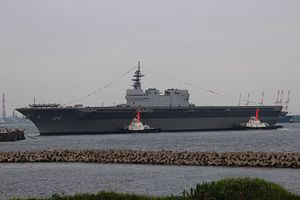Three ships of Japan’s Maritime Self Defense Force (JMSDF) departed on August 26th for a two-month deployment to Southeast Asia and the Indian Ocean.
A JMSDF statement says that the deployment seeks to improve its own operational capability and promote interoperability and cooperation with partner navies, while contributing to peace and stability in the Indo-Pacific region. The flotilla includes the helicopter destroyer Kaga, and the escort destroyers Inazuma and Suzutsuki, and will make port calls in the Philippines, Singapore, Indonesia, Sri Lanka, and India.
The Kaga is Japan’s largest warship, and the second of the Izumo-class of helicopter destroyer. While Japan classifies them as “destroyers,” the Izumos and their predecessor the Hyuga-class, have more in common with “big deck” amphibious assault ships – small helicopter carriers designed to deliver Marines ashore in an air assault.
Kaga’s sister-ship, the Izumo, made a similar deployment last summer, where it conducted exercises with the U.S. Navy.
The 27,000 ton Kaga is smaller than the U.S Navy’s 45,000 ton assault ships, but is still a potent presence, particularly for various archipelagic conflict scenarios in the East and South China Seas.
Japan has not had a true aircraft carrier since World War II, but last year Japanese government sources said that plans to modify the Izumo-class to carry the short-takeoff variant of the F-35 fighter jet were under consideration. The F-35 would add substantial combat power and range to the Izumo and Kaga and could be an important capability to help Japan balance China’s growing navy. China took the prospect seriously enough that its Foreign Ministry warned Japan against making the modifications to carry jets. Meanwhile, China is believed to be working on its third aircraft carrier.
Japan’s newly-released 2018 Defense Program emphasizes two broad objectives. First, ensuring the ability to deter or respond to a spectrum of conflict and disaster scenarios, and second, to stabilize the Asia-Pacific region and improve the global security environment. The Kaga’s deployment is in line with Japan’s effort to promote stability through presence and engagement throughout the region, and increasing the capacity and capability of its partners.
The deployment may also be part of a signal responding to what the Defense Program describes as China’s coercive regional activities to change the status quo and Japan’s broad emphasis on improving its capability to conduct island defense or seizure operations. Japan’s helicopter destroyers would likely play a critical part in rapidly deploying forces to defend or re-take an island. Earlier this year Japan activated an elite amphibious rapid deployment brigade, and the Defense Program includes new spending to improve its other amphibious transport ships, and to expand the land-based anti-ship missile capability that it tested against a target ship with the United States Army at RIMPAC in July.

































